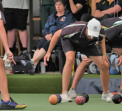Clarity around Woven Carpet Bowling Greens
A message from BIOScapes Group – the industry leaders in greens construction.
In the realm of bowling green construction, we often encounter queries about the choice of surface -particularly, comparisons are sought between BIOScapes Greengauge Woven carpets and other available options. It may come as a revelation that, despite the variety of names these woven carpets bear, they may originate from the same manufacturer, simplifying the selection process for those with a penchant for Greengauge.
A recent case in point involved a club seeking clarity on the distinctiveness of a woven carpet product they were considering. A BIOScapes investigation confirmed the product in question was indeed a Greengauge woven carpet, thereby streamlining their procurement process.
A lesser-known fact among clubs is the extent of research and development invested in the Greengauge woven carpets, which have garnered significant demand for the construction of bowling greens. The issues associated with sun damage to surfaces have mostly been mitigated by modern technologies.
The Greengauge woven carpet has emerged as the premier choice for clubs globally. The GG3 variant has been tailored for the harsh climates of the southern hemisphere. Moreover, Greengauge has innovated a UV-resistant and heavier product for outdoor application, solidifying its position as the world’s leading bowling surface brand.
Prior to deciding on a woven carpet or contemplating a replacement, consider these key points:
Manufacturer Identification
The industry often uses varied terminology for Greengauge woven carpets, leading to confusion during the decision-making process for construction or renovation. It is advisable to verify the actual manufacturer of the carpet, not merely the name it is marketed under. This due diligence could reveal that, despite differing names, the manufacturer might actually be Greengauge.
Understanding GSM
GSM, or grams per square meter, is crucial as it indicates the density of the carpet. A higher GSM denotes a greater stitch rate and more yarn per m2, enhancing the carpet’s durability.
- An 850gsm carpet is generally recommended for indoor use due to its lower yarn density.
- A 1000gsm carpet employs the same yarn as the 850gsm but has a different stitch rate to augment the fabric’s weight.
- The 1050gsm variant, our selection for outdoor environments, boasts the same yarn but is the most durable due to its construction.
Should there be any confusion or questions about your current surface or options you’re considering, we invite you to engage in a transparent and informative discussion with BIOScapes to ensure your club is well-informed and confident in your future decisions.
Reach out to the BIOScapes team via email at admin@bioscapesgroup.com.au or visit the BIOScapes website: https://bioscapesgroup.com.au/




